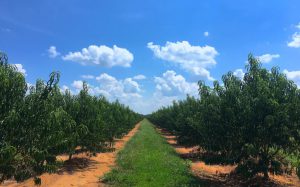We know that some of you are still assessing the extent of the damage due to the late frosts we have seen in Georgia and South Carolina during the past few weeks. For those of you that have lost significant production this year, we want to send our sympathies and also reach out with some advice. The impacted blocks, even if not enough fruit to pick, still need to be maintained in some fashion, or pests and diseases may get the upper hand. In large part, the goal is to maintain tree health and reduce buildup of inoculum for next year – at the cheapest possible price.
Disease management:
Unsprayed trees might experience premature defoliation due to rust or bacterial spot, but this will depend on environmental conditions and geographic location. Middle and southern Georgia counties are more likely to see rust and subsequent premature defoliation. Bacterial spot will cause early defoliation on susceptible varieties if not managed. Bacterial canker might be an increased issue due to the cold damaged limbs and trunks, but there is not much one could do about it anyway.
The easiest approach is to go on a two-week spray program with 10 lbs or so of sulfur (90%) tank mixed with an insecticide (see below). When temperatures climb above 80F, sulfur may cause some phytotoxicity depending on cultivar and spray interval. Scout your trees, and when damage is getting to unacceptable levels, apply the lower labeled rate of captan for continued disease control without further damage. Where bacterial spot is anticipated, apply low rates of copper in tank mixes with sulfur. If copper phytotoxicity becomes an issue, after prolonged periods of no rainfall for example, discontinue applications. Knock pathogen-infected fruit to the ground.
Insect management:
Producers will need to protect the trees from damaging insects (scale and borers for example), so that expense is nonnegotiable. Thus, the two-week spray program needs to include a rotation of insecticides that primarily target scale, borers, and Oriental fruit worm. We recommend a rotation through the season with Assail (acetamiprid; neonicotinoid) at 6 fl oz, Mustang Maxx (zeta cypermethrin; pyrethroid) at 3.8 fl oz, Baythroid XL (beta cyfluthrin; pyrethroid) at 2 fl oz, and/or Diazinon (diazinon) at 2 pt [NOTE: if fruit is available and there is any intention of harvesting it, do not use Diazinon]. Additionally, even relatively small numbers of unmanaged fruit in an orchard can act as a potential reservoir for plum curculio, so incorporating Imidan (phosmet) at 2 lb into the rotation would be recommended in such a case.
This fall, if mating disruption for borers was not used, handgun application to the lower scaffolds, vase, and trunk of chlorpyrifos (3 pt/100 gal) is necessary to suppress peachtree borer. Note that chlorpyrifos is only labeled for 2 applications per year, so even though fruit may not be on the trees, additional applications are prohibited.
Additionally, all blocks, bearing and non-bearing, should continue to receive two dormant oil applications every year. Very thorough spray coverage is essential for effective scale control, striving for 150-200 gal/acre with a 2-4% superior oil solution.
Fertilization recommendations:
Most producers split fertilization in two or three applications, with the first one being applied typically at bloom time. Thus, if an orchard loses its crop due to a late frost, most producers have already put some fertilizer down. It is important to highlight that those nutrients are not lost because 1) the amount of nutrients stored in small fruitlets is negligible, and 2) a remarkable percentage of those nutrients do not actually come from direct uptake of the fertilizer but from reserves build the previous year. However, after losing those fruitlets, the way nutrients are going to be used by the tree after the frost will not be the same as if fruit were on the tree. Since there is no fruit, nutrients uptaken by the tree are going to be allocated to either new growth or to storage organs (depending on nutrient reserves and nutrient mobility). Special attention should be paid to nitrogen as increasing amounts encourage shoot growth; if trees have very low crop or no crop, high applications of nitrogen could induce an excessive shoot growth, which could also reduce flower bud development the following year. Thus, further applications in spring or summer should be carefully thought out and, if no fruit is going to be harvested, there may not be need for applying more fertilizer, unless the orchard showed signs of deficiencies or poor nutrition (e.g. deficiency symptoms, short shoots) the previous year, or there is evidence such as leaf analyses from the previous summer indicating low or deficient nutrient levels.
Other considerations
While the above recommendations are based on solid data and experience, there are other considerations we are not that certain about. A reduced spray program may allow for more inoculum (infectious fungus) to accumulate over the course of the season. We cannot be sure what the consequences of that would be:
- During leaf drop in the fall and when/if conditions are right (prolonged periods of wetness), there might be an increased chance (more season-long inoculum buildup) that wood pathogens such as Phomopsis and bacterial canker get into the tree through the wounds created from leaf drop. It is possible (but data is scarce and not consistent) that applications of captan OR chlorothalonil OR lime sulfur mixed with high rates of copper applied PRIOR to any significant precipitation (or at 20% and 80% leaf drop) will help to reduce these threats. Also, don’t forget that leaf curl is controlled through late fall/early winter fungicide applications.
- The potential buildup of inoculum may require more efficacious fungicides for both scab and brown rot management next year.
Written by Guido Schnabel, Brett Blaauw, Phil Brannen, and Juan Carlos Melgar
